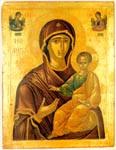|
|
| Portable Icons |
1535-45 Iviron Monastery Wood, egg tempera, 162 x 125 cm Cretan School. Theophanis the Cretan |
|

|
The icon of the Virgin Hodegetria is one of the despotic icons on the iconostasis in the katholikon of Iviron Monastery. The Virgin is depicted on a gold ground from the waist up, holding the Christ Child and turning slightly to the right, according to the austere type of the Hodegetria. Christ is portrayed in an erect frontal pose, making a gesture of blessing with his right hand and holding a closed scroll in his left. In the upper corners are miniatures of the archangels Gabriel and Michael, again from the waist up, turning towards the Virgin with their arms veiled in respect. The Virgin wears a russet mantle edged with gold and a bluish kerchief; Christ a bluish tunic and an orange himation with dense gold highlights. The Virgin's halo is outlined with dots and decorated with a rinceau interspersed with four dotted circles enclosing the symbols of the four Evangelists, a motif rarely seen in the decoration of haloes. Iconographically and typologically, the Iviron Hodegetria is a close copy of the Lavra Hodegetria (1535), which was painted by the Cretan artist Theophanis (Chatzidakis 1969-70, fig. 44. Tsigaridas 1997 (1), fig. 4). Theophanis stamped his own clear imprint on ecclesiastical painting at Meteora and Mount Athos in the sixteenth century. Despite the damage to the faces, at the technical level, the shading and the faultless technique of the white linear highlighting on the faces are identical in both the Iviron and Great Lavra icons. Furthermore, the rendering of the Virgin's garment, with the broad, flat folds on the breast, and the impeccable execution of the gold striation on Christ's clothing have features in common which reveal the identity of the artist. As regards the style, the faces of Christ and the Virgin stand out for their expressive quality and their serene and peaceful air, features identical to those seen in the Lavra icon. Another striking characteristic shared by both icons is the Virgin's intense gaze, with its indefinable sadness as she ponders Christ's future Passion. In conclusion, the iconographical, typological, and stylistic connections between the Iviron and the Lavra Hodegetria make it possible to ascribe the Iviron icon to Theophanis. Its expressive quality allows us to include it among Theophanis's mature works, executed between 1535, when he decorated the katholikon of the Great Lavra, and 1545/6, when he decorated the katholikon of Stavronikita.
| |
|
Bibliography: Tsigaridas 1997 (1) (forthcoming).
| ||
| E.N.T. | ||
| Index of exhibits of Monastery of Iviron 16th century |
||
Reference address : https://www.elpenor.org/athos/en/e218ab41.asp